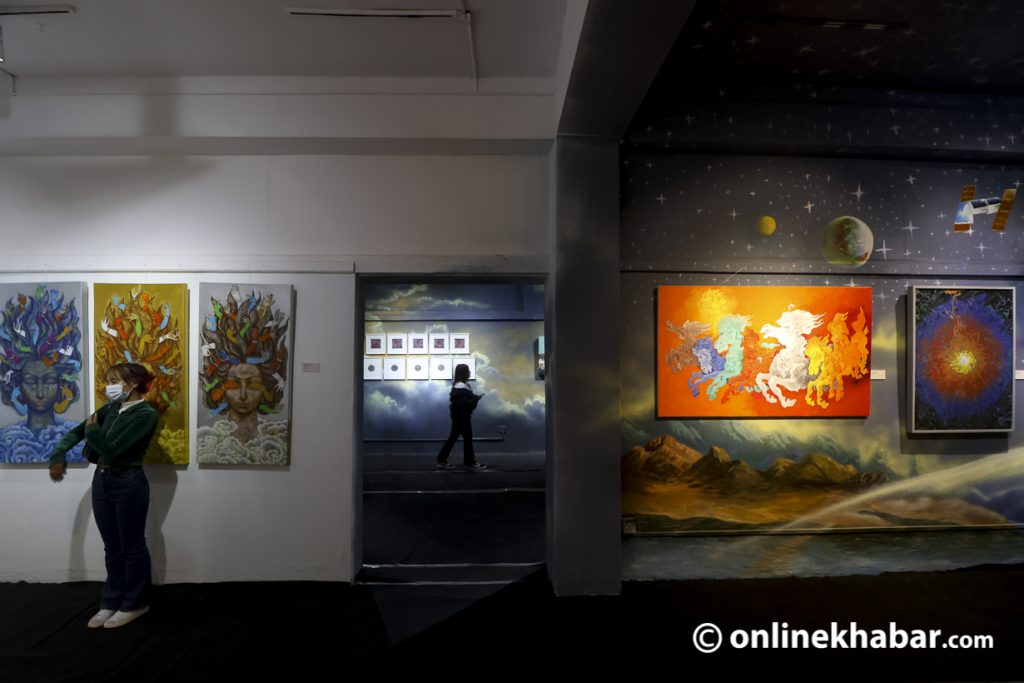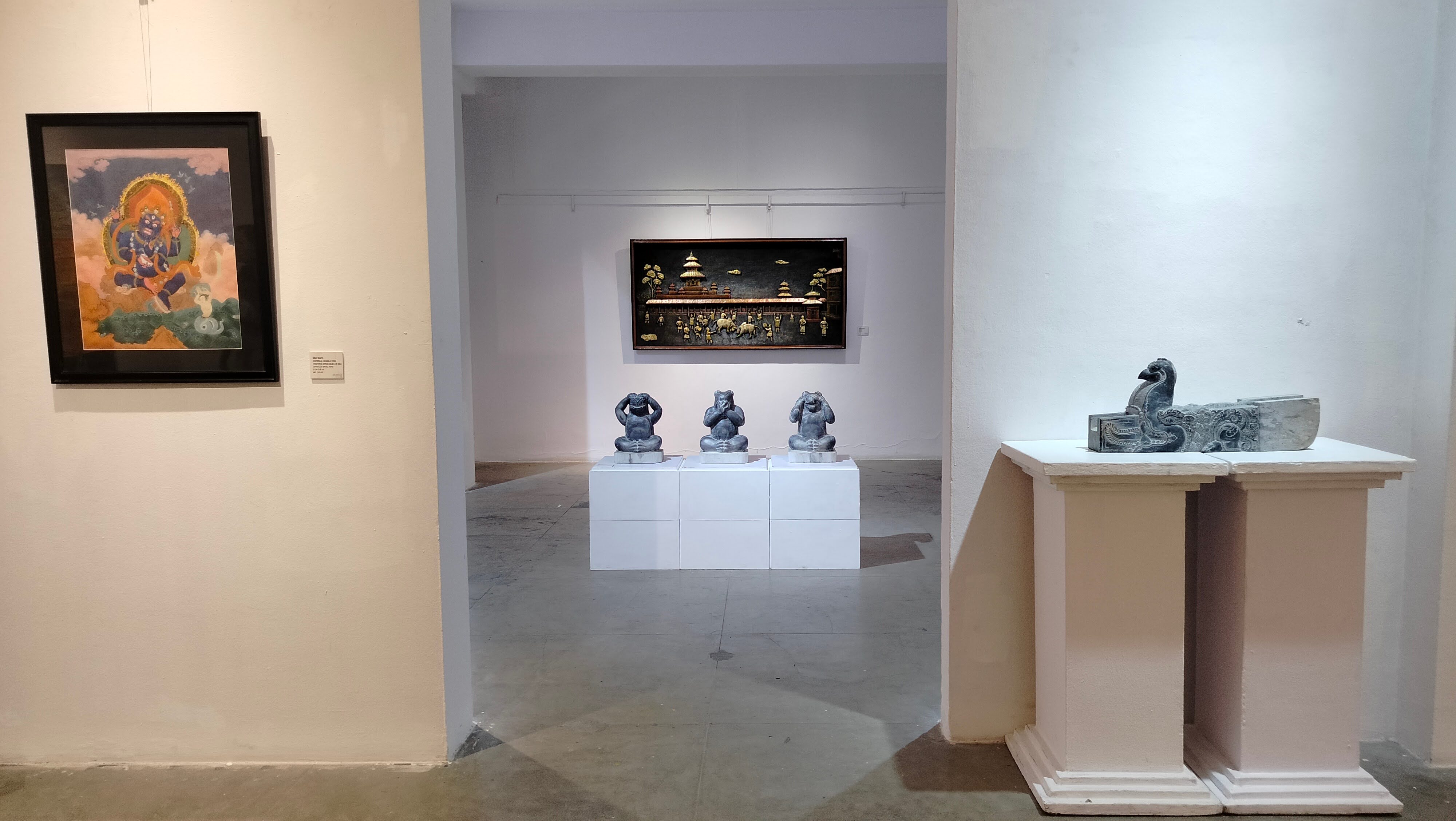
It is a rare opportunity to see folk, traditional and contemporary artworks under one roof. But, Deities of Nepal, an ongoing exhibition, at Nepal Art Council, Babermahal is that rare opportunity for admiring different forms of artworks featured on the same platform.
This thematic exhibition has interwoven the 146 artworks that present a plethora of gods and goddesses. As the title of the exhibition, one can explore various manifestations of Hindu and Buddhist gods and goddesses in the form of paintings, sculptures, installations and more.
This exhibition is one-of-a-kind in its conceptual framework and curatorial approach, displaying artworks of all genres of artists and sculptors from a diverse community of the country.
The exhibition
Deities of Nepal is dedicated to the council’s former chairperson late Satya Mohan Joshi and to commemorate the 60th Anniversary of the Nepal Art Council and the 50th anniversary of the Federation Handicraft Associations of Nepal (FHAN).
In the exhibition, one can see the juxtaposition of the diversity of expression and inspiration of individual artists from different backgrounds and communities, which encourages visitors to contemplate the skill and knowledge of these artists. The council had an open call for the exhibition, in which it received applications from 190 artists to get 160 selected for the final shows.
Swosti R Kayastha, the curator of the exhibition, explains the theme of the exhibition, “Deities have been the first creative expression of humankind. Deities have been presented in every corner of the world. So, for a very long time, Nepali artists have been creating deities on canvas, as statues, etc.”

Moreover, the exhibition also aims at educating visitors about the ancient philosophies of Nepal. Generating awareness of the diversity of Nepali artistic heritage juxtaposing folk art, traditional and contemporary sculptures, paintings and art installations of the sacred deities are highlighting the wealth of their imagery, symbolism and iconography among others, says Kayastha.
The exhibition is spread from the ground floor to the top floor and it could be an overwhelming experience for those who have come here not knowing its conceptual frameworks.
Unique conceptual framework
As you enter the the council gallery, the exhibition having unique conceptual frameworks begins with the theme of creation on the ground floor. You will be awestruck by the effort that has been put into creating the sense of the beginning of the universe.
The gallery on the left showcases Surya (Sun), Chandra (moon) and mandalas representing the galaxies and the universe. Then, the additional attraction is the backdrop of these artworks, which have been painted to give a feel of the universe.

Artist Govind Shah Azad’s painting featuring a flaming sun reflects the importance of the sun in the universe. Likewise, artist Sushma Shakya’s prints using the print-making technique symbolically showcase the origin of the universe through seeds. Then, artist SC Suman through Mithila paintings and using Om depicted the origin of the universe.
Jeevan Rajopadhyay, an abstract painter practising it for a long time, has realistic paintings of Lords Brahma, Bishnu and Maheshwar at the exhibition. Another artist Sangi Shrestha showed a flame emanating from a lotus flower on a blue background inspiring one to observe beyond the physical world.
Highlights of the exhibition
Altogether there are six themes of the exhibition—artworks that evoke basic tenets of Hinduism or Buddhism such as Brahma, Atma or the AUM motif; Shaiva: Ganesh, Kumar, Bhairav and Shiva-Parvati; Vaishnava: Vishnu, Vishnu Avatar; Shakti: Kumari, Sapta/AshtaMlmatrika, Navadurga, Dasa Mahavidhya; Astral deities: Navagraha; Buddhist deities: Buddha, Lokesvara, Tara, Yogini, Tantric deities, etc.

A special installation of Indra Jatra, the biggest festival of Kathmandu, is on the top floor. “We also have the educational programme on the theme of the exhibition for all walk-in visitors, school children and university students,” says Kayastha. Then, there are unique installations of Newa and Tharu culture, highlighting their artistic practices.
Special booths by local companies—Aamo Nepal, Kazi Studios, Lahar Srjana, Moni’s Creation, Nepal Knotcraft Center, Suiro Teas, Valhalla, and Art by Shivani l–are also featured in the exhibition.
Meanwhile, public lectures by scholars from India and Nepal, at Indian Embassy, Lainchaur, Kathmandu have also been organised as a part of the exhibition. The principal of Aksheswar Traditional Buddhist Art College, Naresh Shakya, gave a presentation on Hari Hari Hari Hari Vahan Lokeshwar in Newa Buddhist Society and Kayastha on curating deities of Nepal.
Likewise, Indian scholars Ashutosh Bapat and Manjiri Bhalerao gave their lectures on the iconography of Vishnu and that of Shiva and Shakti, respectively.
The exhibition has become a bridge that accumulated different genres of artists together to exchange their knowledge and skills. Artist Ujay Bajracharya says, “There are rare occasions in Nepal when traditional artists and modern artists share the same platform and this exhibition has certainly played a role of a bridge for them.”
The exhibition that began on November 28 continues till December 11.
























